When I was in the 8th grade my Uncle Buzzy gave me a stagecoach kit for Christmas. Opening the box, I was soon overwhelmed. As I recall, the only recognizable components were the wheels. The rest of the kit was blocks of raw wood in assorted sizes and a vaguely diagrammatic plan sheet with no text. That was 1964, and that kit has long since disappeared. I guess I've always considered it to be unfinished business.
Looking through an early 2010 ModelExpo catalog I saw the description of their new Concord Stagecoach kit. Further searching led to the Amati version, released around the same time.
My original (mis-)understanding was that the ModelExpo (aka Model Trailways) kit is a licensed variant of the Amati. I assumed that some of the parts--e.g.: the wheels, leather boot coverings and luggage--would be interchangeable. But, on examination, the two kits are in different scales and have little in common.
Unable to find any reviews, and owing to the usual combination of internet+credit card+boredom, with a tincture of red wine, I ended up with one each of the ModelExpo and Amati kits.
As of this date, I have not yet assembled either kit and can't comment on aspects of construction. However, this being the internet, I'm exercising my license to feign expertise and vehemently state ill-informed opinions on some of the material and design choices.
What follows is not meant to be a review. It is intended as an illustration and a comparison of the more noticeable features of the two kits, and is not comprehensive.
If I can answer any specific questions about the kits, not addressed in the following pages, feel free to ask. [Use the CONTACT button in the ![]() dropdown at the top of the page or the shiny rotating logo at the bottom.]
dropdown at the top of the page or the shiny rotating logo at the bottom.]
Here you see the two boxes. The Amati (on the right) is smaller, has a glossier label and is much more tightly packed.
The Model Trailways (MT) kit weighs in at 4 lbs., 15 oz (2.2 kg). The Amati is 6 lbs, 14.5 oz (3.1 kg).
MT chose a 1:12 scale, and the finished kit is said to measure 13 3/4 inches in length, 8 3/4 inches in height. This model does not include a tongue or other harness, aside from the first set of singletrees.
Amati uses a 1:10 scale, which yields a length for the finished carriage of 16.5 inches. There is a tongue, which likewise has no harness after the first set of singletrees. Including the tongue, the completed model is an impressive 27.3 inches.
A look at the plans. The MT plans are four sheets of 36 x 24 inches each.
The Amati are ten sheets at a slightly smaller 28 x 19 inches.
The Amati plans and booklets are in the familiar bi-language format (in this case, Italian and English). The MT documentation is English-only.
Both kits include comprehensive guides to all the laser cut parts, which greatly assist in identification.
You can see in these photos that the MT instruction manual makes frequent use of color photographs. The Amati relies on line-drawings (subtly more elegant in style than those in the MT) and black and white photos. The overall look of the bi-lingual Amati manual is more stylish in presentation. However, I find the single spiral-bound MT manual more detailed in its text, more straightforward and easier to follow.
The Model Trailways wood totals 22 ounces (0.6 kg) and is basswood and plywood.
The Amati wood weighs in at a remarkably greater 64 ounces (1.8 kg). Some of that (17 ounces of it) is due to the use for two pieces of a fine grained composite (aka particle) board 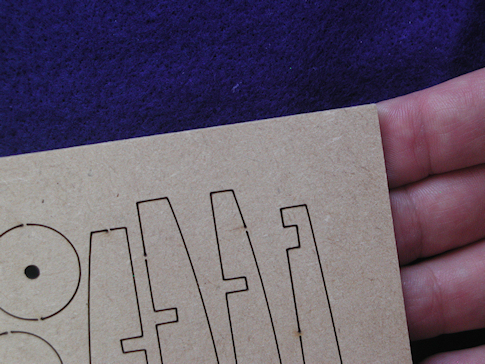 --a much denser and heavier material. There's also quite a bit of mahogany and walnut--used for components such as the chassis--and the usual plywood.
--a much denser and heavier material. There's also quite a bit of mahogany and walnut--used for components such as the chassis--and the usual plywood.
Here are the photo-etched brass sheets. It's obvious there are more brass components in the Amati, but that's not the whole story (see the following).
The MT kit has quite a few cast white metal components, some very small threaded rods and nuts, as shown in the photo to the left, and four small assembled brass hinges 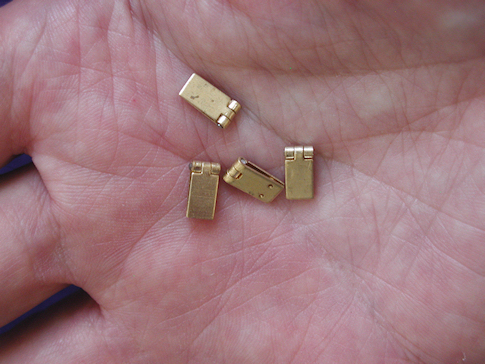 for the doors. There is also included an assortment
for the doors. There is also included an assortment 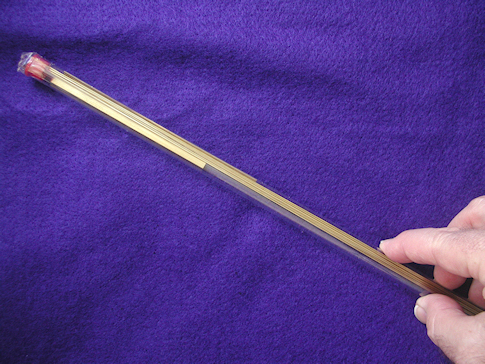 of brass wire and flat stock. Where, for example, the Amati railings on the top of the coach are one piece in flat brass, the MT railings must be formed in a jig and soldered from brass wire.
of brass wire and flat stock. Where, for example, the Amati railings on the top of the coach are one piece in flat brass, the MT railings must be formed in a jig and soldered from brass wire.
This is true for nearly all the metal components: The MT parts (except for that one brass sheet) are cast in three dimensions while the Amati are etched out of flat sheet.
The wheels in the MT kit are completely assembled and cast from white metal. I believe the ModelExpo catalog describes these as "wood-grained". However, I don't detect any obvious wood grain detail.
The Amati wheels are assembled from pre-cut plywood components for the rims and walnut strips for the spokes.
For the iron rims, nuts and other wheel hardware, MT uses a 1/64 inch automotive gasket material made by Phelps Industrial Products (thanks to ModelExpo's parts department for that bit of information). This is the dark green-gray strip seen in the middle of the photograph in the THE THROUGHBRACES section (below). I have to say that I question the wisdom of this design choice. In handling these parts, a large and bothersome quantity of a fine, dark dust-like residue heavily coats fingers and every other surface it contacts. The long-term stability of this material is very questionable.
MT includes decals representing either the Wells Fargo or Butterfield stage companies.
The Amati decals are for Wells Fargo only, but one nice little detail is the inclusion of scenic panels for the doors. Painted Scenes 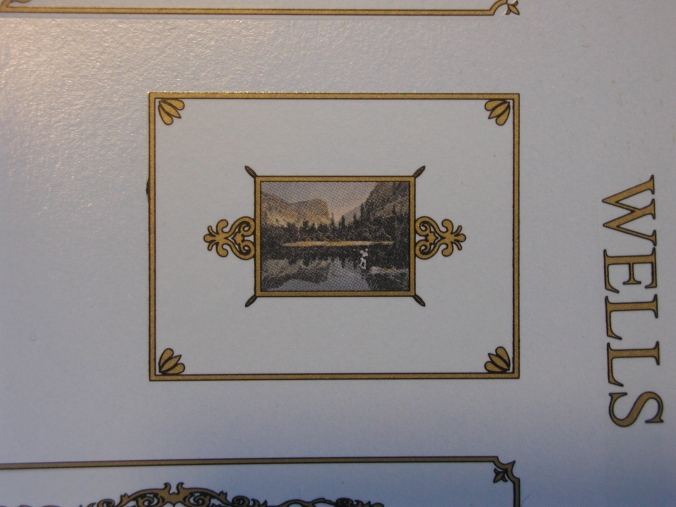 , especially of mountains, were a common decoration on stagecoach doors.
, especially of mountains, were a common decoration on stagecoach doors.
Throughbraces--massive ox leather strips which suspended the carriage in the chassis--were an innovation in the Concord stagecoach design. The two kits implement the throughbraces in entirely different ways.
Amati's throughbraces are cut in one piece each from the particle board material (as shown along the bottom edge of the sheet in the photo to the right).
The MT kit attempts to more accurately simulate the original leather, using a vegetable-fiber gasket material (also from Phelps Industries), 1/64 inch thick. This is the roll of lighter colored material shown in the photograph above left. The throughbraces must be cut in strips and glued in layers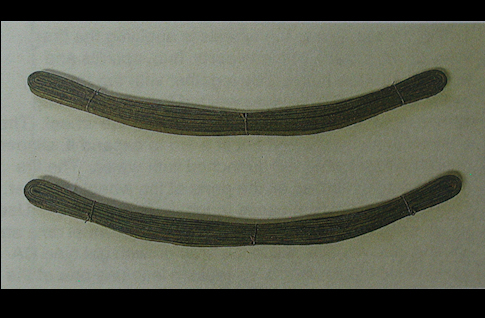 to build up to an appropriate thickness.
to build up to an appropriate thickness.
All the seats in the MT kit must be carved and shaped from wood pieces and painted.
Amati provides a sheet of foam core board, as you would find in an art supply store, which must be cut to the shapes of the interior and exterior seats. Over this, a fabric-backed dark green vinyl material 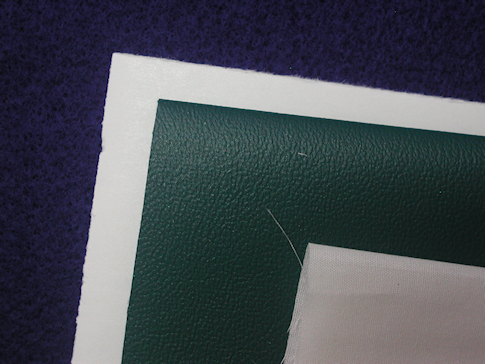 is glued and the surface is then dimpled
is glued and the surface is then dimpled 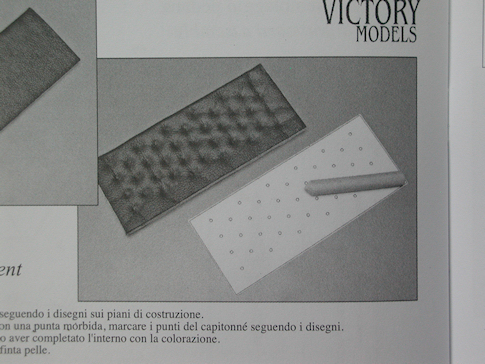 (using the provided template) to resemble buttons.
(using the provided template) to resemble buttons.
There are no decorative panels included for the interior of the MT coach.
Amati provides a textured paper sheet printed with decorative patterns to simulate a fabric wall covering. (This same sheet contains the leather texture used for the luggage and sway straps.)
Amati chose not to include leather coverings for the boots--the front and rear external luggage compartments.
MT provides patterns to cut these pieces from the same roll of gasket material used for the throughbraces (mentioned in the preceding section). There are also brass buckles for the straps.
The window blinds and sway straps of the MT kit also use the lighter colored gasket material. The window blinds in the Amati kit are a white fabric, and the sway straps are cut from the leather-printed paper.
What first caught my eye when looking at the catalog descriptions of the two kits is the luggage and cargo included by Amati. There is brass hardware for the luggage clasps. And...gotta have them two cool miniature Winchesters.
The MT kit does not have similar accessories.
So there you have it: Two very well-made and highly detailed kits, each with unique features.

UPDATE: A modeler in Germany has provided links to his build reports on the Amati kit. The first link is a collection of photos of the kit contents (similar to those above) and the second link is details of the construction. The text is in German (Google Translate is of some help). The pictures and discussion of some of the issues encountered during the build are very useful.
This page uses the optional Paddington font.